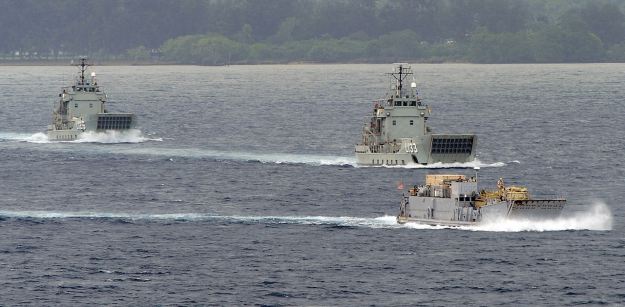Tag Archives: nextwar
WarPlan Crimson: The NextWar Schedule
WarPlan Crimson is the long-view schedule for NextWar and its Sea Control Podcast
NextWar Upcoming Topic Weeks:
Challenges of Intelligence Collection – Jul 7-13
Editors: Jillian McGhan (j.danback-at-gmail.com)
Chris Stockdale-Garbutt (cjstockdalegarbutt-at-gmail.com)
From conventional military surveillance to cloak-and-dagger espionage, how are ways that challenges in intelligence collection have been overcome and what new challenges must we overcome today?
Almost Navies – Jul 28-Aug 3
Editor: NEXTWAR Editing Team (NEXTWAR(at)CIMSEC.ORG)
Despite their recent pillorying, PMC’s have existed since before the condotierre and will continue to exist after America’s campaigns. We’ll discuss their utility and future.
Strategic Communications – Aug 18-24
Editor: Nicolas Di Leonardo (nicolas.a.dileonardo(at)gmail.com)
You keep saying words, I do not think they means what you think they mean… to everyone else.
Sea Control Podcast Schedule:
Jun 30: The View From China (Dean Cheng)
Jul 7: Sea Control Asia-Pacific
Jul 14: Offensive Sea Control (RADM Rowden)
Jul 21: Sea Control East Atlantic
CIMSEC Comic:
Can you Draw? Doctrine Man isn’t the ONLY one who can draw snarky pictures! We’re looking for someone or someones who would like to do a weekly comic for CIMSEC on maritime strategy/policy/tech.
WarPlan Crimson: The NextWar Schedule
WarPlan Crimson is the long-view schedule for NextWar and its Sea Control Podcast
NextWar Upcoming Topic Weeks:
Defense Innovation Failures – Mar 24-29
Editor: Matt McLaughlin (matthew.mclaughlin.1(at)gmail.com)
Too little attention is paid to the innovative failures and dead ends. We’re going to fix that.
Private Military Contractors – Apr 14-19
Editor: Emil Maine (emil.maine(at)heritage.org)
Despite their recent pillorying, PMC’s have existed since before the condotierre and will continue to exist after America’s campaigns. We’ll discuss their utility and future.
Wargaming – May 5-10
Editor: Adam Kruppa (adam.kruppa(at)gmail.com)
From the table-top to the joint exercise, how do we mimic the world in ways that is useful (or not) for security and foreign policy?
Theories of Power – May 26-31
Editor: CIMSEC+The Bridge
Writers from The Bridge, CIMSEC, and the academic world discuss their ideas on power and strategy in the military realm.
Sacking of Rome – Jun 16-21
Editor: Paul Pryce (prycep(at)cya-ajc.ca)
The United States is the mightiest power on earth. We spend too much time concentrating on how the U.S. could fail, and less on how Hannibal or the Goths could succeed.
Strategic Communications – Jul 7-12
Editor: Nicolas Di Leonardo (nicolas.a.dileonardo(at)gmail.com)
You keep saying words, I do not think they means what you think they mean… to everyone else.
Sea Control Podcast Schedule:
Mar 10: The Crimean Crisis
Mar 17: TBD
Mar 24: Anthony Arend and Maritime Law
Mar 31: Robert Sutter and Chinese Decision Making
Apr 7: Sea Control Europe
Apr 14: T. Walton and TX Hammes on Navy Doctrine and Escalation
Apr 21: Sea Control Asia-Pacific
Apr 28: Behind the Curtain
Upcoming Projects: Doctrine Man isn’t the ONLY one who can draw pictures! We’re looking for someone or someones who would like to do a weekly comic for CIMSEC on maritime strategy/policy/tech.
WarPlan Crimson: The NextWar Schedule
 WarPlan Crimson was the War Department’s operational plan for the invasion of Canada, it is also the long-view schedule for NextWar and its Sea Control Podcast
WarPlan Crimson was the War Department’s operational plan for the invasion of Canada, it is also the long-view schedule for NextWar and its Sea Control Podcast
NextWar Upcoming Topic Weeks:
Drone Tactics Week – Mar 3-8
Editor: Dave Blair (daveblair130(at)gmail.com)
The practical view of how a drone could be used outside (or furthering) their current model.
Defense Innovation Failures – Mar 24-29
Editor: Matt McLaughlin (matthew.mclaughlin.1(at)gmail.com)
Too little attention is paid to the innovative failures and dead ends. We’re going to fix that.
Private Military Contractors – Apr 14-19
Editor: Emil Maine (emil.maine(at)heritage.org)
Despite their recent pillorying, PMC’s have existed since before the condotierre and will continue to exist after America’s campaigns. We’ll discuss their utility and future.
Wargaming – May 5-10
Editor: Adam Kruppa (adam.kruppa(at)gmail.com)
From the table-top to the joint exercise, how do we mimic the world in ways that is useful (or not) for security and foreign policy?
Sacking of Rome – May 26-31
Editor: Paul Pryce (prycep(at)cya-ajc.ca)
The United States is the mightiest power on earth. We spend too much time concentrating on how the U.S. could fail, and less on how Hannibal or the Goths could succeed.
Strategic Communications – Jun 16-21
Editor: Nicolas Di Leonardo (nicolas.a.dileonardo(at)gmail.com)
You keep saying words, I do not think they means what you think they mean… to everyone else.
Sea Control Podcast Schedule:
Feb 24: CAPT Rodgers on the USS PONCE
Mar 3: CAPT Moore’s “More with Moore”
Mar 17: ASB with TX Hammes and Tim Walton
Mar 24: Anthony Arend and Maritime Law
Mar 31: Robert Sutter and Chinese Decision Making
Upcoming Projects: Sea Control may soon be broadening its perspective. The Phoenix Think Tank will soon be running a monthly “East Side of the Pond” edition of Sea Control and an Asia/Pacific version may soon follow.




